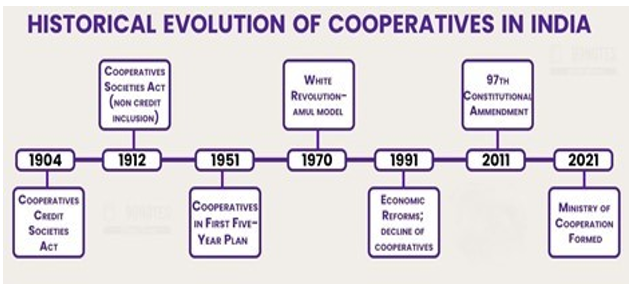SYLLABUS
GS-2: Government policies and interventions for development in various sectors and issues arising out of their design and implementation.
GS-3: Agriculture and food management.
Context:
Recently, the Union Home Minister unveiled the National Cooperation Policy 2025 in New Delhi.
More on the News
- This National Cooperative Policy will be effective from 2025 to 2045.
- The ministry said a new policy was needed because of globalisation and technological advancements in the past two decades.
- The vision of the new cooperation policy is to build a Viksit Bharat by 2047 through ‘Sahkar Se Samriddhi’.
- The policy is drafted by a 48-member committee led by Suresh Prabhu.
- This Policy has been introduced after a 23-year gap, following the previous policy announced in 2002.
About Cooperative Society
A cooperative is an autonomous association of persons, united voluntarily to meet their common economic, social, and cultural needs and aspirations through a jointly owned and democratically member-controlled enterprise.
Key Features of the National Cooperation Policy 2025
- The policy mission will be achieved through the following 16 objectives over the next 10 years, grouped under six strategic mission pillars
| Pillar | Objectives/Strategies |
| Strengthening the Foundation | · Create a conducive legal and regulatory environment through timely reforms to ensure autonomy, transparency, ease of doing business and good governance.· Foster accessible, affordable finance and equal business opportunities.· Enhance cooperation among cooperatives, strengthen the structure and expand geographical reach. |
| Promoting Vibrancy | · Promote the development of a cooperative business ecosystem.· Encourage multi-dimensional expansion, including global market access and income enhancement. |
| Making Cooperatives Future-Ready | · Enhance technology adoption for efficient and transparent management.· Transform cooperatives into professionally managed economic entities while preserving cooperative principles. |
| Promoting Inclusivity and Deepening Reach | · Promote inclusivity, member centrality and nationwide outreach through cooperatives.· Position cooperatives as a people’s movement by involving youth and women. |
| Entering New and Emerging Sectors | · Promote entry into new and emerging sectors.· Encourage eco-friendly practices and a circular economy for sustainability. |
| Shaping the Young Generation for Cooperative Growth | · Inspire youth, especially in rural/semi-urban areas, to pursue cooperative careers.· Promote development of standardized, high-quality cooperative education and content.· Build an ecosystem for skilling and upskilling youth and women for cooperative employment.· Ensure availability of practitioners as trainers, faculty, and mentors in adequate numbers.· Develop systems to ease hiring in cooperatives and simplify job search for aspirants. |
Need for a New Policy
- The previous National Policy on Cooperatives, released 2002, focused on organizing cooperative economic activities efficiently.
- Over the past two decades, the world has witnessed radical transformations at individual, societal, national and global levels, driven by globalization and rapid technological advancements, especially in communication and information technology.
- These changes made it essential to revisit and reformulate the policy to address evolving sectoral needs and ensure its sustainability in the present economic context.
Global Initiative for Cooperatives
- The International Day of Cooperatives (CoopsDay) is celebrated annually on the first Saturday of July, established in 1923 by the International Cooperative Alliance (ICA) and recognized by the UN in 1995.
- It aims to raise awareness about cooperatives and their role in poverty reduction, employment and social inclusion.
- The UN has declared 2025 as the International Year of Cooperatives (IYC 2025) to promote cooperatives as people-centred and sustainable enterprises.
Cooperative Societies in India
The formation of cooperative societies is recognised as a fundamental right under the Constitution of India.
The establishment of a separate Ministry of Cooperation in 2021 marked the beginning of a new era for the cooperative movement, focusing on farmers, women, and rural development.
India has over 8 lakh cooperative societies, which include around 2 lakh credit cooperatives and 6 lakh non-credit cooperatives.

- Non-credit cooperatives operate in sectors such as housing, dairy, labour, sugar, consumer goods, marketing, fisheries, textiles, services, processing and healthcare.
- The cooperative sector has a total membership of around 30 crore people, with PACS (Primary Agricultural Credit Societies) alone accounting for over 13 crore members spread across the country.
Constitutional Provisions related to the Co-operative Societies
The 97th Constitution Amendment Act, 2011 granted constitutional status to the Cooperative Societies and made the following provisions, namely:
- Right to form cooperative societies was included as a Fundamental Right by insertion of the words “cooperative societies” in Article 19(1)(c) in Part III of the Constitution.
- Article 43B was inserted in Part IV of the Constitution as Directive Principle of State Policy for promotion of cooperative societies.
- Entry 32 of the State List of Seventh Schedule
- Part IX B ‘The Cooperative Societies’ was inserted with provisions for incorporation, regulation and winding up of co-operative societies.


